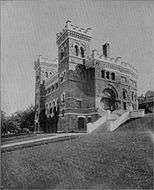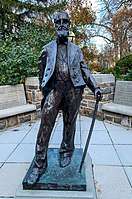Asa Packer
Asa Packer (December 29, 1805 – May 17, 1879) was an American businessman who pioneered railroad construction, was active in Pennsylvania politics, and founded Lehigh University. He was a conservative and religious man who reflected the image of the typical Connecticut Yankee. He served two terms in the United States House of Representatives (1853–1857).
Asa Packer | |
|---|---|
 | |
| Member of the Pennsylvania House of Representatives | |
| In office 1842–1843 | |
| Associate Judge of Carbon County | |
| In office 1843–1844 | |
| 4th President of the Lehigh Valley Railroad | |
| In office 1862–1864 | |
| Preceded by | J. Gillingham Fell |
| Succeeded by | William M. Longstreth |
| 6th President of the Lehigh Valley Railroad | |
| In office 1868–1879 | |
| Preceded by | William M. Longstreth |
| Succeeded by | Charles Hartshorne |
| Member of the U.S. House of Representatives from Pennsylvania's 13th district | |
| In office March 4, 1853 – March 3, 1857 | |
| Preceded by | James Gamble |
| Succeeded by | William H. Dimmick |
| Personal details | |
| Born | December 29, 1805 Mystic, Connecticut |
| Died | May 17, 1879 (aged 73) Philadelphia, Pennsylvania |
| Political party | Democratic |
| Spouse(s) | Sarah Minerva Blakslee |
| Occupation | Businessman, railroad executive, politician |
Early life
Packer was born in Mystic, Connecticut in 1805. He moved to Pennsylvania where he became a carpenter's apprentice to his cousin Edward Packer at Brooklyn Township, Pennsylvania, which is located on the Pennsylvania-New York border. He also worked seasonally as a carpenter in New York City and later in Springville Township, to the south of Brooklyn Township, and he met his wife Sarah Minerva Blakslee there. Yates writes of his early life: "Asa and Sarah settled on a farm, and in the winter he went to Tunkhannock on the Susquehanna and used his skill in carpentry to build and repair canal boats." This continued for 11 years.[1] In 1833, Packer settled at Mauch Chunk in Jim Thorpe, Pennsylvania, where he became the owner of a canal boat carrying coal to Philadelphia. He then established the firm of A. & R. W. Packer which built canal-boats and locks for the Lehigh Coal & Navigation Company.[2]
Business activities
Packer urged the Lehigh Coal & Navigation Company to adopt a steam railway as a coal carrier, but the project was not then considered feasible.[3] In 1851, he became the major stockholder of the Delaware, Lehigh, Schuylkill & Susquehanna Railroad Company, which became the Lehigh Valley Railroad Company in January 1853, and they built a railway line from Mauch Chunk to Easton between November 1852 and September 1855.[4] Construction commenced on the Mauch Chunk-Easton line just as Packer's five year charter was to expire.[3] He built railways connecting the main line with coal mines in Luzerne and Schuylkill counties, and he planned and built the extension of the line into the Susquehanna Valley and thence into New York state to connect at Waverly with the Erie Railroad.[2] Among his clerks and associates during this period was future businessman and soldier George Washington Helme.
Politics
Packer also took an active part in politics. In 1842–1843, he was a member of the Pennsylvania House of Representatives. In 1843–1844, he was county judge of Carbon County under Governor David R. Porter. He served two terms as a Democratic member of the U.S. House of Representatives beginning in 1853.[2] Packer made an unsuccessful bid for the Democratic Party's Presidential nomination in 1868. He got the party's nod for the 1869 Pennsylvania Governor's race, but lost the campaign to John W. Geary by 4,596 votes, one of the closest statewide races in Pennsylvania history.
Lehigh University
Asa Packer was rather laconic and reticent, so when word spread that Packer was to found a university, or aid one, there were various speculations.[5] The final spot chosen, on South Mountain in Bethlehem, Pennsylvania, could not have been much happier: as it nestled in with a preexisting religious community, the Moravians, and additionally was the future home of benefactor, and collaborator, Bethlehem Steel Co. So then, in 1865, he gave $500,000 and 60 acres (243,000 m²), later increased to 115 acres (465,000 m²) in Bethlehem, Pennsylvania, as a technical school for the engineering professions, designed to help the growth and development of the Lehigh Valley. Lehigh University was chartered, and instruction began, in 1866.[2] The first main building, Packer Hall (now the University Center) was completed in 1869, and of stone, as Packer himself stipulated.[6] With Packer's generosity, Lehigh was able to offer education tuition free for 20 years, 1871–1891, before the economic troubles of the 1890s forced the University to reverse this policy.
Two other important buildings were either constructed, or construction had commenced, while Packer was still alive: the other two being The President's House, to the West, and slightly downhill of Packer Hall, and Linderman Library (after daughter Lucy Packer Linderman), to the east, and again slightly downhill from the center building, Packer Hall. Both were relatively large prominent structures, and all of stone. The more utilitarian buildings were constructed immediately adjacent to Packer Ave. (south side), while the larger, and more important structures for the university as a whole, tended to be set back, and up the hill. After the initial gift of one half million dollars, Packer was still able to consistently give to the young University. He was active in management, though his ideas were not always determinative.
Tuition free education was instituted in 1871, intended as a means to compete with other young technical schools, especially Lafayette and Cornell, boost the size of the student body, and increase popular interest and recognition generally. This was not due to the generosity of Packer's initial gift, which had been by then near entirely spent on stone buildings and laboratory equipment, but rather his continual giving, and that of the estate upon his death.[7] His will bequeathed $1,500,000 as an endowment for the university and $500,000 to the university library, and gave the university an interest of nearly one third in his estate when finally distributed.[2]
Family
Packer was married to Sarah Minerva Blakslee (1807–1882), daughter to Zophar and Clarinda Whitmer Blakslee. The Packers had seven children: Lucy Packer Linderman (1832–1873), Catherine Packer (1836–1837), Mary Packer Cummings (1839–1912), Malvina Fitzrandolph Packer (1841–1841), Robert Asa Packer (1842–1883), Gertrude Packer (1846–1848), and Harry Eldred Packer (1850–1884).
Legacies

Packer's residence, the Asa Packer Mansion became a museum, opened for tours in 1956, and was named a National Historic Landmark in 1985. Packer was a member of St. Mark's Episcopal Church and contributed large amounts of money to this beautiful Gothic Revival Church that is located in downtown Jim Thorpe. St. Mark's was declared a National Historic Landmark in 1987. There is also an elementary school in Bethlehem, Pennsylvania, named after Packer. The university naturally continues to honor its founder: Lehigh has a large and quite attractive portrait by Boutelle of him, now in the Alumni Mem. Bld., a quaint statue, and there is Founder's Day.[8] The first meeting of the Board of Trustees, July 27, 1865, was held at the Sun Hotel, now the Sun Inn, still standing and serving guests.[9]
A life-sized bronze statue of Packer by Karel Mikolas was donated by the Lehigh University Class of 2003 and officially dedicated in 2008. It stands outside the Alumni Memorial Building on campus.[10]
- Legacy
 Lehigh University's first library, constructed at the cost of $100,000 by Asa Packer as a memorial to his daughter, Lucy Packer Linderman.
Lehigh University's first library, constructed at the cost of $100,000 by Asa Packer as a memorial to his daughter, Lucy Packer Linderman. Packer Memorial Church of Lehigh University, which was erected by Mrs. Mary Packer Cummings in memory of her family.
Packer Memorial Church of Lehigh University, which was erected by Mrs. Mary Packer Cummings in memory of her family. Statue at Lehigh University
Statue at Lehigh University
See also
References
- Yates 1983, p. 9.
-

- Yates 1983, p. 13.
- "Lehigh Valley Railroad".
- Yates 1992, pp. 27–28.
- Yates 1983, p. 17.
- Yates 1992, pp. 38–39, 41–42.
- Yates 1983, p. 19.
- Yates 1992, p. 29.
- Harbrecht, Linda (11 January 2005). "Asa comes home". Lehigh News. Retrieved 16 November 2019.
- Yates, W. Ross (1983). Asa Packer: A Perspective (PDF). Bethlehem, PA: Asa Packer Society.
- Yates, W. Ross (1992). Lehigh University : a history of education in engineering, business, and the human condition. Bethlehem Pa: Lehigh University Press. ISBN 978-0-934223-17-1.
- The Asa Packer Mansion Museum.
- Asa Packer at The Political Graveyard
- United States Congress. "Asa Packer (id: P000006)". Biographical Directory of the United States Congress. Retrieved on 2009-03-24
External links
- Asa Packer letters and ephemera. Available online through Lehigh University's I Remain: A Digital Archive of Letters, Manuscripts, and Ephemera.
| Party political offices | ||
|---|---|---|
| Preceded by Hiester Clymer |
Democratic nominee for Governor of Pennsylvania 1869 |
Succeeded by Charles R. Buckalew |
| U.S. House of Representatives | ||
| Preceded by James Gamble |
Member of the U.S. House of Representatives from Pennsylvania's 13th congressional district 1853–1857 |
Succeeded by William H. Dimmick |